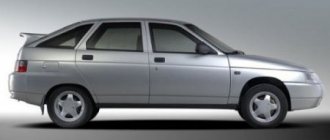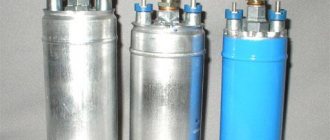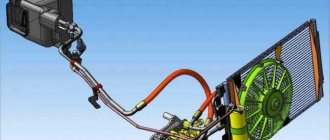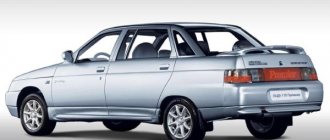Despite the fact that by the time it was launched into mass production in 1996, the VAZ-2110, according to many experts, was a technically and morally outdated model, for the domestic automobile industry it was a serious step forward. This model began to use modern achievements in automotive production: galvanized body, electronic injection system, the ability to install additional options such as power steering and electric windows and much more. The car was produced in three body styles: sedan, station wagon and five-door hatchback. Production continued until 2007, after which the VAZ-2110 was replaced on the assembly line by the Lada Priora, which is a deep restyling of the Ten.
VAZ-2110 1.5 8 valve
The base engine for the VAZ-2110 was an in-line carburetor 8-valve engine with a volume of 1500 cm3, developing a power of 72 hp. and a torque of 104 Nm. Cars with this engine were produced until 2000. Literally a few months later, production of VAZ-21102 began, equipped with an 8-valve injection 79-horsepower VAZ-2111 engine, developing a torque of 116 Nm. Both engines were offered with a 5-speed manual transmission and could use AI-92 and AI-95 gasoline as fuel.
Real fuel consumption VAZ-2110 1.5 8 valve
- Vitaly, Krasnoperekopsk. After selling my old V8, which not only ate my brain, but also hit me on the head with a spoon, I started looking for a new car. New – in the sense of different, there was no money for a car from the showroom, even a domestic one. Since the car was bought for purely work purposes, I looked at the VAZ-2110, with a simple 1.5 liter carburetor engine, 1999, as a normal option. Of course, with a carbor the consumption is higher than with an injector, the car was taken for work - that's one thing, but injectors are more expensive - that's two things. I got from 10 to 13 in the city and about 7 liters on the highway.
- Nikolay, Pskov. I had the “dozens” for about five years - and it started to break down literally a month after purchase, although I bought it with a mileage of 40 thousand km, 2000. Since recently all my weekends began to be spent in the garage, I gave up on this thankless task and sold it cheap to my son - let him work with it. I immediately advised me to put on gas - on the highway I got from 6 to 7 liters, in the city it was consistently 10 liters.
- Denis, Pinsk. I got the car from my father - he bought himself a Skoda, and he offered me to buy his VAZ-2110 cheaply and in installments, like a family, so to speak. Because I didn’t have money for a new or even a used car - this was the only acceptable option. Its consumption is quite high, as for its class - in the city I consistently get 10-11 liters, on the highway about 7.5 liters, but the good news is that you can use 92 gasoline, and the spare parts are inexpensive.
- Stanislav, Moscow. My work car, and my second one. I often travel to the Moscow region, so I took a car so that I wouldn’t mind killing myself on the country roads. By the way, this is also why I bought the carburetor - if something breaks, you can always try to fix it yourself. I drive mostly outside the city, the carb is adjusted normally, so on the highway my consumption is about 6.5 l/100 km. In the city it was never less than 11 liters.
- Sergey, Sochi. I bought the car in 1998, in the showroom. Brand new “ten”, 1.5 engine, black. The joy knew no bounds – for about the first couple of months. Then the “ten” began to actively break down and crumble, and so actively that after three and a half years I barely sold it for about 30% of its original price. Consumption by this time had increased from 9 liters to almost 12 liters in the city and from 6 to 8 on the highway.
- Georgy, Saratov. I bought the car in 2014. VAZ-2110, 2002, one owner. The car has a complete engine, the gearbox and chassis have been completely rebuilt, the body has been repainted and is not damaged (I checked). In principle, the option is excellent, the only downside is that it’s not an injector, but a carburetor, straight out of the past. And the consumption is 7.5 liters on the highway, 10-11 in the city.
- Alexey, Stary Oskol. In general, I didn’t even plan to buy a “ten” - the purchase was accidental. A neighbor in the yard was urgently selling a car - I knew that he had it in excellent condition, although it was from 1998. When he named the price of 50 thousand, I immediately realized that a second car would not hurt us - I would be traveling around for work. I drove it for six months - the consumption of 12 liters in the city is of course a lot, and small shoals began to appear, so I sold it - I even earned 20 thousand, so it’s not a loss.
Other cars: Audi A4 fuel consumption owner reviews
How to determine consumption and cause
If you are starting to worry about the high fuel consumption of this car, you can conduct simple research yourself. To do this, at a regular gas station, the tank is filled, as they say, “to the cutoff.” Separately, fill a canister, for example, a 20-liter canister, and add gasoline from it until the neck of the tank is full. After this, the Lada drives 100 km, preferably at approximately the same speed, in order to find out how much the car consumes in a particular cycle. Now we pour the remaining gasoline from the canister into a measuring container and again into the neck of the tank until it stops. All that remains is to calculate how much fuel is left in the measuring container and find out how much we have used over a hundred kilometers.
In all cases, if a VAZ 21102 car begins to consume too much gasoline, you need to first discover the cause, and only then proceed to treatment. In the case where the owner lives in a rural area and the vehicle is used there, in principle you should not hope for low consumption. Off-road driving is associated with increased loads on the engine and chassis, which leads to excessive consumption.
VAZ-2110 1.6 8 valve
In 2000, a modification of the VAZ-21101 appeared. An 8-valve injection VAZ-21114 engine with a volume of 1596 cm3 was installed as a power unit. It developed a power of 81 hp. and reached a torque of 120 Nm, and a 5-speed manual gearbox was used as a transmission.
Reviews about fuel consumption of VAZ-2110 1.6 8 valve per 100 km
- Alexander, Kiselevsk. After I wrecked two of my Toyotas (Corona and Karina), I decided that I needed to take something domestic. The normal option is VAZ-2110. I didn’t really consider the carbs, they suck, but the 8-valve injector is just inexpensive and economical. True, its consumption is high - 12 liters in the city, I couldn’t get less, on the highway it’s generally 9-10, but I drive consistently 130-140 km/h.
- Dmitry, Mezhdurechensk. The “ten” itself is not a bad car. Compared to the same “nine” and “nine-nine” it is more spacious, softer and more comfortable. But the engine is a complete g...o in general, even though it is an injector. Gasoline guzzles like a cow, in the city 12 liters is a stable consumption. Well, it breaks all the time. I rode this one for 2 years, sold it and bought it with a “one hundred and twenty-fourth” engine - it’s just a song.
- Nikolay, Volgograd. I inherited the car from my father - a model with an eight-valve 1.6 engine. Phew, I had a lot of trouble with it - it kept breaking down. If it weren’t for the constant need for a car, I would have sold it, but it was useful for repairs. Another minus is gasoline consumption, in the city it is consistently 11 liters, on the highway from 7 to 8 liters.
- Stanislav, Kharkov. To say that I was expecting an ambush when I picked up my VAZ-2110 with a mileage of 50 thousand km is to say nothing. But the car was really needed... But, to my surprise, the only problem was the squeaks in the cabin and crappy plastic. No, of course it broke - but in moderation and did not hit the pocket. By the way, the consumption is also normal - city 10, highway 7, I don’t know why people are complaining about this engine.
- Anatoly, Vologda. About seven years ago I had a “ten” - I remember it with warmth and tenderness, since I didn’t drink blood and didn’t particularly demand money. And consumption of 10 liters in the city now seems like a pittance, after the Kruzak, which simply eats gasoline in buckets.
- Semyon, Ryazan. VAZ-2110, 2003, engine 1.6 8V. The third VAZ and, in my opinion, one of the best among the products of the domestic automobile industry. I drive mainly outside the city, the consumption is within 6-7 liters, depending on the speed and load. In the city, 9 liters in summer, 12 in winter - by the way, it starts without any problems at all.
- Denis, Perm. Our VAZik was bought with a mileage of 60 thousand from a pensioner friend - he got that mileage on it from 2002 to 2010. That the mileage is not twisted - I am sure, since I know my grandfather well, neighbors in the garage, he drove it to the dacha once every 2 weeks and that’s it. Everything is perfectly adjusted, everything works like a clock - and consumption on the highway is 6 liters, in the city 9.5 liters.
- Eduard, Ufa. I bought the “Ten” six months ago. I rarely drive it, as I plan to tune it for racing. Now there is an 8-valve 1.6 l engine - a vegetable engine, it’s not an option to drive at all, even a chip will not help. The only thing is that the consumption in the city is 10-11 liters and all the advantages. I plan to throw it out of the car and install something more powerful, for example 1.8 or 2.0 liters.
Other cars: Nissan Navara fuel consumption
Coolant temperature sensor
Removing the fan regulator on a VAZ 2110 On a VAZ 2110, sensors can be used for different purposes, but most of them are mounted in the engine compartment.
On an 8 or 16 valve engine, the fan sensor is a device designed to activate the fan. We are talking directly about a fan designed to cool a hot engine. The controller turns on automatically when the power unit reaches a certain temperature. But it can also turn on when the engine is off. At first, this fact may be alarming for many owners of the “ten”, but there is nothing wrong with it, so there is no need to worry.
It is necessary to highlight the advantages of this controller:
VAZ-2110 1.5 16 valve.
The production of modifications of the VAZ-21103 with a 16-valve 1.5-liter VAZ-21120 engine began in 2000. This engine developed a power of 92 hp. and a torque of 128 Nm and was deservedly popular for its reliability and efficiency. Like all other power units, it was coupled with a 5-speed manual transmission.
Fuel consumption rate VAZ 2110 1.5 16 valve – reviews
- Sergey, Moscow. Second car in the family. I bought it literally for a year or two especially for my wife, who just got her license and is learning to drive - give her your Subaru, I feel sorry for it. The result is obvious - I’ve already hit the rear bumper twice, burned out the clutch, and other little things. But repairs are cheap and fuel consumption is low - in the city it’s 12 liters on average, I imagine if she drove a Suba, it would be 20 liters in general.
- Ilya, Vladivostok. I bought the car at the dealership. Yes, we have a lot of inexpensive Japanese cars, but all my three attempts to buy a right-hand drive Japanese car ended with me spending 2 times more on repairs than it cost. In the end, I decided to buy a new “ten” - not Japanese, but new. I sold it six months ago in excellent condition, consumption was about 6 liters on the highway and 9 in the city. By the way, I recommend cleaning the injector after 150 thousand km.
- Peter, Tolyatti. Previously there was a “nine nine”, then I decided to take something newer and in 2006 I bought a “ten” with a one and a half liter injection engine. The VAZ Ten is as different from my previous VAZ as heaven and earth - consumption is an order of magnitude lower, it doesn’t exceed 8.5 l/100 km in the city, the highway is consistently 6.5 l.
- Dmitry, Moscow. I took the car from my father - he bought it at the end of 2006, with a 1.5i engine. For me this was the best option - I knew the condition of the car, because... my father took good care of it, he didn’t destroy the engine or gearbox, it was parked in a ventilated and dry garage, and he hardly left it in the winter. I bought it in 2012 and have been driving it for 3 years now. True, my consumption is never less than 11 liters, but my dad’s was up to 10 liters - but I drive more.
- Anna, Krasnogvardeysk. Our good friend was leaving for another country and selling an apartment and a car, and he gave away his “ten” at such an interesting price that we immediately decided to take it as a second car. We mainly drive it to the dacha and out of town - there is a large trunk, everything is convenient and the consumption on the highway is only 6.5 liters when empty and up to 8.5 liters - if with a trailer.
- Vasily, Terkum. The car was bought back in 2010 - VAZ-21103, mileage 150 thousand. Immediately after the purchase, almost 30 thousand was invested in chassis repairs, modifications and minor tuning. For our rural areas, this is the best option, because it is impossible to find spare parts for a foreign car if necessary, but they are always available for a “ten”. And in terms of fuel - I fill up 92 petrol with a bang, consumption on the highway is 7 liters, in the city 8-9 liters.
Other cars: Hyundai Tussan fuel consumption
Air regulator
The ECM is the electronic engine control system. And she needs to know how much air to supply for the amount of fuel supplied. These two parameters are closely interrelated because they allow you to create an optimal air-fuel mixture.
Having determined the amount of air, the system determines the required volume of gasoline. The air sensor is responsible for the suction volumes. The disadvantages of this device include:
How does this sensor work? Let's try to figure it out.
Article on the topic: Technical features of the VAZ 2114
VAZ-2110 1.6 16 valve.
Since 2004, the VAZ-2110 has received the most successful engine for the entire time of its production. This is a 16-valve injection engine VAZ-21124, which is deservedly considered one of the best engines developed at AvtoVAZ - it is still in production and all new models of the plant are equipped with it. The engine develops a power of 90 hp. and torque of 137 Nm and is offered with a 5-speed manual transmission.
Gasoline consumption VAZ 2110 1.6 16 valves per 100 km. Reviews
- Vitaly, Vladimir. I bought my “ten” in 2012. I drove it for three years - I’m very pleased with the car, I think that for the money it’s one of the best options. A really budget car with low fuel consumption (up to 10 liters in the city, up to 7 liters on the highway) and cheap to maintain.
- Svetlana, Kazan. The second car in the family - my husband bought it for me so that I could learn to drive. Immediately after the purchase, I made a complete overhaul, put it in order and said, “Here, learn.” That's what I'm learning. I drive calmly and slowly, consumption in the city is about 10 liters, but this is with traffic jams. On the highway it’s generally 6 liters, but I don’t drive more than 90 km/h.
- Andrey, Perm. The main problem of the VAZ-2110 is our disgusting assembly. The car itself is not bad, the engine is quite powerful and economical - in the city the average output is 9 liters, no more. But everything creaks and rattles, it fell off here, it came loose there - when will we be able to do something normally?
- Alexander, Smolensk. I bought the “ten” a year ago. On the advice of friends, I took a 1.6-liter sixteen-valve engine - they say it is the most successful and at the same time economical. I drive hard, but the consumption of more than 11 liters in the city does not happen - this is despite the fact that I immediately press the pedal to the floor from the traffic light.
- Nikolay, St. Petersburg. In fact, the VAZ-2110 surprised me. I took it from the first owner in 2012, the car itself is 2006. The condition is perfect - the owner took good care of the car, I also don’t destroy it and fix all the problems right away. Consumption in the city is from 8 to 10 liters, depending on the situation, I think it’s not much.
- Artem, Tambov. Immediately after the purchase, I replaced all consumables, technical fluids and did diagnostics - after all, the mileage was 140 thousand km. I had to do some body repairs because the previous owner damaged the body. But the engine is in perfect condition, it worked inaudibly and on the highway the consumption was about 5.5 liters in total, in the city up to 8 liters.
Why gasoline consumption may increase
This may be due to the following reasons:
- The gas tank was filled with poor quality fuel;
- The driver drives the car and uses aggressive driving techniques;
- Incorrect engine operation.
In winter, the VAZ 2110’s fuel consumption increases due to the fact that first of all the car needs to be warmed up, including not only its engine, but also the interior of the car.
Each owner of a VAZ 2110 car should carry out technical diagnostics to identify any breakdowns in it. This is especially important to do if it begins to consume more gasoline.
Coolant temperature indicator
Antifreeze or coolant is used to cool the engine. To ensure proper operation of the power unit, the coolant also has its own controller. In its functionality, this regulator is vaguely reminiscent of the choke that is equipped with 8- and 16-valve carburetor engines of the “ten” and other vehicles. The sensor itself is designed to monitor the temperature of the consumable.
Installing a new antifreeze sensor
In fact, this device also provides fuel regulation. If the power unit is running cold and has not yet warmed up, it will receive more gasoline for normal operation. Readings about the coolant temperature are displayed on the control panel in the vehicle interior. In accordance with these indicators, the driver will always be able to find out about the overheating of the unit by the way the sensor arrow on the dashboard begins to move into the red zone.
The antifreeze temperature sensor periodically fails; it is characterized by the following malfunctions:
Speed sensor
8- and 16-valve “tens” are also equipped with a speed sensor. Thanks to this device, the electronic engine control system receives information about how fast the vehicle is moving. The sensor itself is installed on the vehicle's gearbox. As practice has shown, on VAZ 2110 cars this controller is characterized by fairly high reliability and a long service life.
But domestic developers could not do everything perfectly, so this device is characterized by several malfunctions:
Two speed controllers
Replacement process
Replacing the coolant temperature sensor VAZ 2110
To check and replace the temperature device, you will need the following tools and materials:
Note. The temperature sensor is located in the VAZ 2110, often in the intake manifold near the thermostat housing, rarely in the cylinder head. It is installed so that the tip comes into contact with the coolant. Only in such cases is his signal correct. If the coolant level is low, the sensor readings may be incorrect.
Crankshaft regulator
New crankshaft controller for the “ten” Depending on the type of car, on a 16- and 8-valve engine, the location of all controllers may be different.
However, all of these devices combine into one functioning system, and the crankshaft adjuster is no exception. Thanks to this controller, the electronic engine management system of the “tens” can independently determine at what point to supply gasoline and a spark through the spark plugs in order to ignite the combustible mixture. In fact, the design of the device is a magnet, as well as a coil of thin wire. The crankshaft sensor has certain advantages:
This controller is installed on the oil pump, actually at the very top of the shaft teeth. Or rather, one millimeter from the cloves. You can learn more about how to replace this controller yourself from the video below (the author of the video is the channel In Sandro’s Garage).











